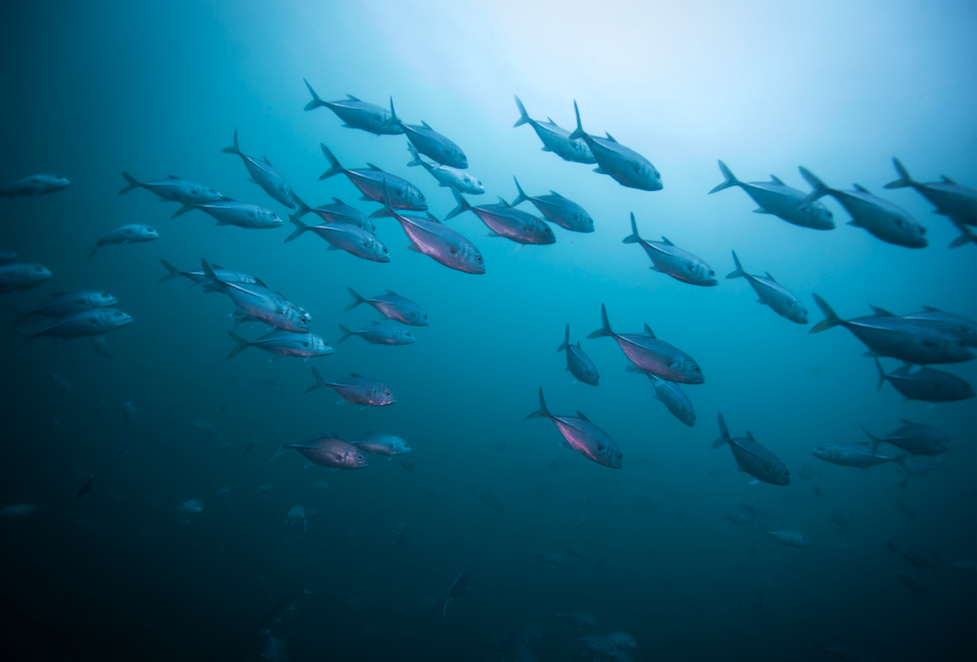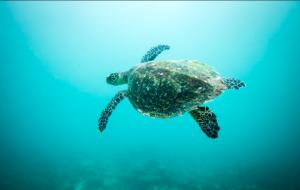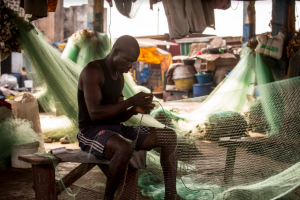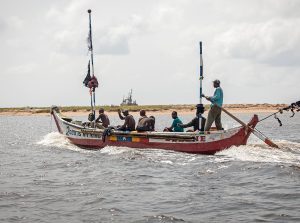We live on a blue planet. Our oceans cover 70 percent of the Earth’s surface, contain 90 percent of the planet’s living biomass; produce more oxygen than all the world’s forests and absorb around 30 percent of global carbon dioxide. “Our rainwater, drinking water, weather, climate, coastlines; the oxygen we breathe are all ultimately regulated by the seas and oceans” (SDG14).
The world’s oceans drive global systems that make the Earth habitable for humankind. Together the seas and oceans are the ‘beating blue heart’ of our planet.
Oceans provide a home to some 200,000 known species and perhaps a million more yet to be identified. For some 3.5 billion coastal people, oceans have massive cultural and economic value as the cornerstone of their livelihoods and are fundamental to their identity. Countless millions of people depend directly on seas and oceans for food, employment and income. Marine life is the single largest source of protein consumed on the planet and global ocean assets are valued at a staggering $24 trillion.
Yet today, the ecological and economic security of our oceans is under threat – they are becoming warmer, more acidic, more polluted and massively over-fished. Some estimates suggest that up to 90 percent of the world’s large ocean fish, species like cod, halibut and swordfish, have been lost since the 1950s, while the United Nations’ Food and Agriculture Organisation (FAO) makes clear that around 90 percent of the world’s fish stocks are fully-fished or over-fished. At the same time illegal, “pirate” fishing operators use damaging, banned fishing gear to fish in protected areas, working without licences or respect for sustainable limits, simply seeking to maximise short-term personal profits without concern for the cost to the environment and our shared future.
But, as fish stocks decline, there is also massive growing demand for fish – and capacity to fish – as the world’s human population is set to reach around 9.7 billion people by 2050, an increase of well over 3 billion since 2000. Vulnerable, often poorer, coastal communities suffer the worst consequences of this over-exploitation of fish stocks and the misuse and degradation of marine environments. Now, science clearly tells us that climate change poses a damning threat to the fundamental building blocks of marine life.
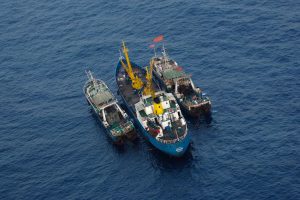
IN THE PHOTO: Illegal transhipment at in sea in Guinea. CREDIT: EJF
To achieve Sustainable Development Goal 14 (SDG14), designed to “Conserve and sustainably use the oceans, seas and marine resources for sustainable development” there needs to be a massively enhanced global, coordinated and ambitious new effort around conservation to end illegal fishing; ensure truly sustainable limits to fishing; curb and control pollution; protect the high-seas and deep-sea environments; strengthen the ability of coastal communities to protect their own livelihoods and environment, and ultimately deliver effective action to combat global warming.
The Environmental Justice Foundation (EJF) is working to investigate and expose environmental problems and their associated human rights abuses. We lead high-level advocacy to combat illegal fishing, human trafficking and slavery in global fisheries, and work directly with coastal communities building their own capacity to protect the marine resources they depend on.
Illegal “pirate” fishing: the enemy of sustainable, secure fisheries
Illegal “pirate” fishing operators are ravaging wild fish populations across the globe, undermining efforts to ensure sustainable, legal and ethical fisheries. Flouting laws aiming at fisheries management and marine conservation, “pirate” fleets frequently operate without licences and use banned and destructive fishing equipment, exploit protected and prohibited areas, and target vulnerable species and fish stocks. They steal from some of the world’s poorest and most vulnerable communities.
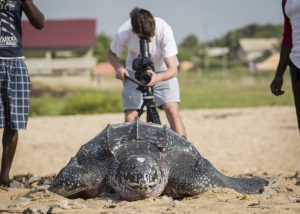
IN THE PHOTO: Female leatherback turtle making its way back to the sea. CREDIT: EJF
Global losses due to illegal, unreported and unregulated (IUU) fishing are estimated at between US $10 billion and US $23.5 billion per year. Concerted action against “pirate” fishers has to become an urgent priority in the efforts to achieve the SDG14 goals.
West African waters are estimated to have the highest levels of IUU fishing in the world, representing up to 37 percent of the region’s catch. Working with Republic of Sierra Leone Armed Forces (RSLAF) Maritime Wing, EJF has observed crews discarding up to 75 percent of their catch; juvenile fish, commercially ‘valueless’ species, and the finned bodies of sharks and guitarfish, which were thrown back into the ocean dead, a waste of precious marine life. This kind of unselective fishing in ecologically important and fragile coastal waters is decimating fish stocks.
Ninety percent of vessels documented by EJF in West Africa are bottom trawlers, which drag heavy trawl equipment along the seabed, damaging the habitat and creating high levels of by-catch: marine life including sharks and turtles caught incidentally as the net is dragged through the water.
Time to end the worst fishing practices:
We need to end the practice of highly destructive bottom trawling – particularly for shrimp – on fragile sea-bed habitats and the deep-sea ecosystems that we now know are host to a vast and important biodiversity. Bottom trawling is responsible for as much as half of all discarded fish and marine life. Critically important species of fish, marine mammals and turtles, as well as seabirds, are caught, killed and discarded as so-called “by-catch” in shrimp and other bottom trawling operations. Such methods cannot be justified.
IN THE PHOTO: Illegal fishing threatens 85% of fish stocks, as well as many threatened marine and coastal species such as sharks, seabirds and turtles. CREDIT: EJF
The rapid depletion of fish populations in Sierra Leone’s coastal waters jeopardises the livelihoods of around 30,000 artisanal fishers and 200,000 workers employed in the country’s seafood sector, which is vital to both food security and the national economy. In Sierra Leone, fish represents over 60 percent of all animal protein consumed in the country – without the resource, people will go hungry, some will starve.
Sierra Leone is estimated to be losing US $29 million each year to illegal fishing, but it is not alone. EJF is witness to similar trends across West Africa. Along with the economic losses, “pirate” fishing in West Africa severely compromises the food security and livelihoods of coastal communities.
Ending pirate fishing in West Africa
Since 2006, EJF has been empowering communities most at risk of “pirate fishing”, helping them to expose illegal practices that put legitimate fishers at a disadvantage and steal food from the mouths of the poorest and most vulnerable. Beginning in Sierra Leone with one vessel and one fisherman, EJF’s Fisheries Information Network (FIN) has now expanded across West Africa, the Horn of Africa and South East Asia.
The network connects local activists and artisanal fisher communities with our remote, satellite monitoring technologies enabling us to document and identify fishing boats suspected of illegal fishing. Information is provided to fishing authorities in the vessel’s flag State (responsible for the regulation of a vessel’s activities); the coastal State in whose territorial waters illegal fishing has occurred; and the port States, where the catch will be unloaded. Given the nature of international seafood supply chains, it’s important to also alert potential market states such as those in the European Union, where illegal products are ultimately consumed.
This approach linking grassroots research and investigations with remote vessel tracking and high-level advocacy is being replicated by EJF in Ghana, in collaboration with Hen Mpoano, a local Ghanaian organisation.
In Ghana, “pirate” fishing by industrial vessels is widespread, forcing artisanal fishers into their own destructive practices in the face of collapsing fish stocks. To help break this cycle, EJF and Hen Mpoano are piloting a smartphone application that will allow artisanal fishers to document illegal activities and provide crucial evidence for enforcement agencies.
We are also building the capacity of artisanal fishers to make their needs and concerns heard in national decision-making processes, and to secure recognition of traditional enforcement mechanisms in national law. This is combined with advocacy, to achieve ambitious fisheries reforms, including putting an end to destructive practices, dramatically reducing the number of licences for the industrial trawl fleet, and implementing fisheries restrictions that are informed by robust scientific evidence.
IN THE PHOTO: EJF’s work connects local activists and artisanal fisher communities with our remote, satellite monitoring technologies enabling us to document and identify fishing boats suspected of illegal fishing. CREDIT: EJF
These actions will help deliver better fisheries transparency and “net to plate” supply chains involving regulators, businesses, governments and the fishers themselves knowing what takes place at every stage. By doing so, we hope to usher in true sustainability and equity in the sharing of these invaluable and irreplaceable resources.
Moving forward
At EJF we recognise the direct link between environmental security and people’s livelihoods and well-being. We understand that our collective short-term thinking and mismanagement of natural resources are extinguishing our planet’s life support systems and, for many people, are the driving force behind widespread poverty and hunger.
EJF believes the environment and its protection should be central to all our efforts to eradicate poverty and support long-term development.
It is no exaggeration to say that fishing is a lifeline to hundreds of millions of people around the world. Nor is it an exaggeration to say that the future of this source of food and income is at risk of total collapse. With one in six people dependent on fish as their main source of animal protein and over 90 percent of global fish stocks believed to be over-exploited or fully exploited, the need for meaningful action could not be more urgent.
SDG 14 was specifically designed to deliver the results the world needs. Its objective “to conserve and sustainably use the oceans, seas and marine resources” is bold and simple in its iteration, yet presents a profound challenge.
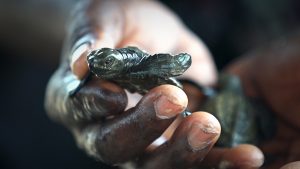
IN THE PHOTO: EJF is supporting grassroots education and community leaders to protect marine turtles in West Africa. CREDIT: EJF
2017 indicators point to continued global deterioration of coastal waters as a consequence of overfishing, agricultural runoff and eutrophication, ocean acidification and a spiralling volume of devastating plastic pollution. This plastic is now found ingested by creatures at the very base of marine ecosystems, just as it chokes large charismatic animals such as cetaceans (whales and dolphins), turtles and seabirds.
To combat these challenges and meet the key SDG 14 indicator: to sustainably manage and protect marine and coastal ecosystems – will require a complete reversal of the current trajectories.
As it is now clear that marine habitats and species play a key role in the ocean carbon cycle – both as biological carbon sinks absorbing CO2 emissions and blue carbon stores – it is evident that establishment of vastly larger and more representative networks of Marine Protected Areas (MPAs), both in national territorial waters and on the high seas is an urgent priority. With only around 4 percent of the world’s oceans protected in some way, there are compelling conservation, ecological and economic arguments for a rapid, large scaling of MPAs. SDG 14 calls for a minimum of 10 percent of coastal and marine areas to be protected by 2020 and while some progress has been made toward this target, EJF argues that much more must be done. Given the unparalleled and mounting pressures of unsustainable utilization, this figure needs to be more than doubled in the very near-term, and crucially, significant areas of the high seas must be urgently conferred as “no-take” MPAs to protect their biological integrity.
EJF supports the calls of others for a network of biologically representative MPAs representing at least 30 percent of our seas and oceans and to achieve this by 2030.
Critical to the success of MPAs and that of our wider seas and oceans – in protecting marine biodiversity and productivity, and helping mitigate climate change – will be the provision of effective monitoring, control and surveillance and robust enforcement action to curtail illicit and unsustainable activities. Many existing MPAs, the so-called “paper parks” lack the management and enforcement needed to end damaging activities. Their existence deludes us. We must protect more and protect better if we are to ensure the integrity of our global seas and oceans and ultimately their continued ability to protect each and every one of us.
IN THE PHOTO: Local fishermen in Liberia. CREDIT: EJF
In a box:
60 percent of the world’s major marine ecosystems have been degraded or are being used unsustainably (UNEP, 2011). Since the 1980’s an estimated 20 percent of global mangroves have been lost and 2719 percent of coral reefs have disappeared (UNDP, 2012).
As I have already mentioned, Introducing transparency to all efforts aimed at curbing abuses can prove to be the most cost-effective long-term means of driving positive change. A vital, relatively cheap and effective tool to build transparency will be the mandatory requirement for Unique Vessel Identifiers (wherever possible based on IMO numbers) for all fishing vessels over 30 gross tonnes. The requirement to make publicly available a full list of vessels licensed to fish would be virtually cost-free, easy to implement and have a profound impact.
Critical actions should also include an end to unmonitored transhipments, which are often used to launder illegally-caught fish into supply chains and the requirement for digital systems and particularly digital catch, licence and landing documentation, along with ship’s log and crew manifest.
Lastly, driving the widespread ratification and implementation of the Port State Measures Agreement (PSMA) is compelling in its potential impact. These would prove game-changing, allowing enforcement agencies and key stakeholders to identify potential abuses and act against them. These changes to the architecture of fisheries management are increasingly affordable and technologically feasible; they are logistically well within our reach and they could be applied now. What is needed is the political will and direction to require them.
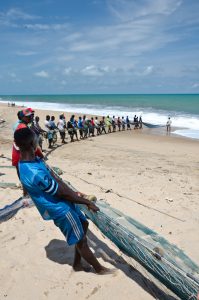
IN THE PHOTO: Fishermen in Ghana. CREDIT: EJF
Alongside Government action, I see a key role for business to support transparency and other measures to eradicate the illegal operators. In doing this and helping to ensure the long-term sustainability of the oceans, they will, after all, be helping to ensure their own long-term profitability. For both governments and business – and indeed for individual fishers and consumers – these actions should, at the very least, be prompted by enlightened self-interest.
Clearly, in tandem with curbing illegal “pirate” fishing, action on SDG 13 – combat climate change – will be key to achieving SDG 14: failure in either goal will almost certainly undermine the other. EJF’s message to world leaders as they move to implement all of the SDGs – and notably SDG 13 and 14 – is an appeal for them to show a greater vision and ambition, greater commitment and greater action to the protection of our natural world – the world that underwrites all other elements of our collective well-being.
Put simply, protecting the marine environment may be our greatest hope for achieving equitable, sustainable development for all.
Editors note: The opinions expressed here by Impakter.com columnists are their own, not those of Impakter.com


